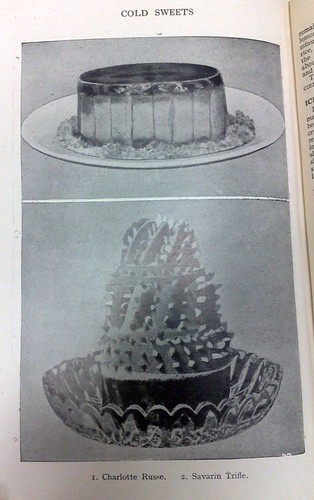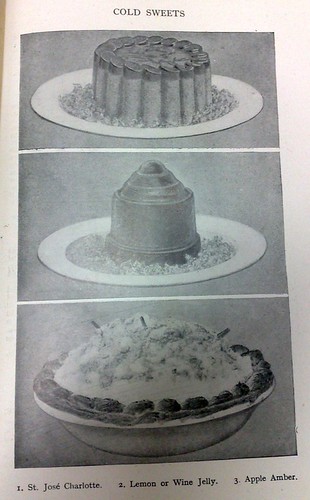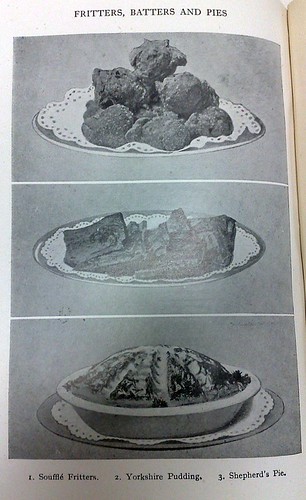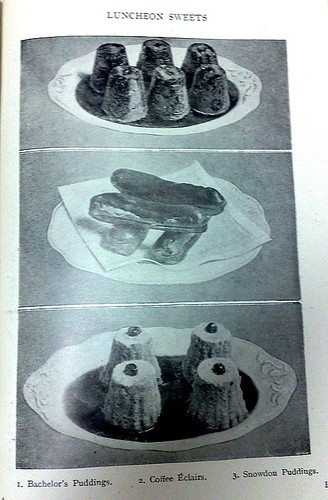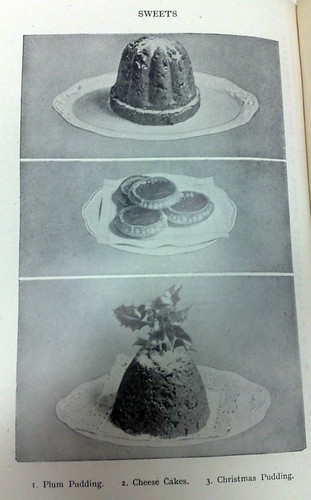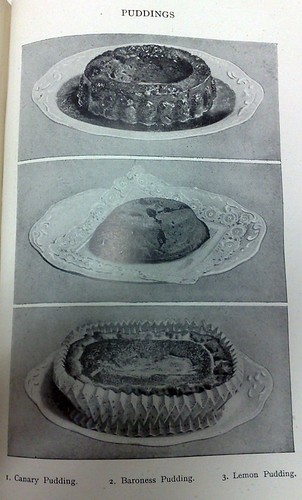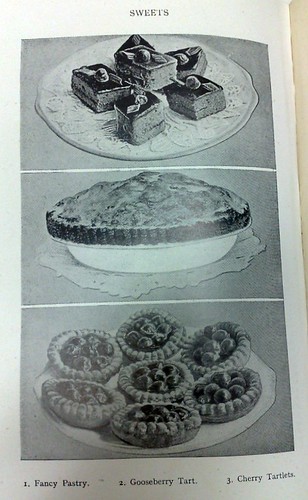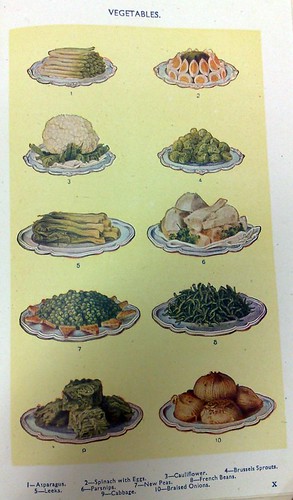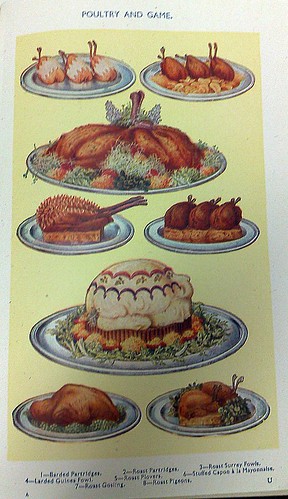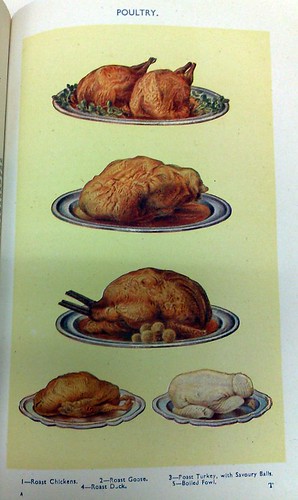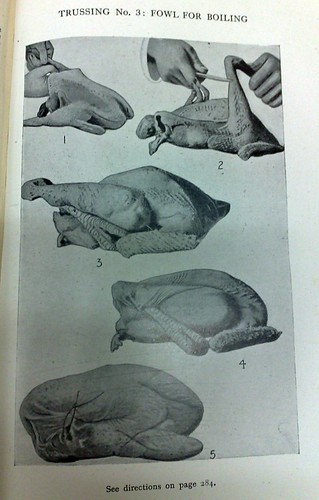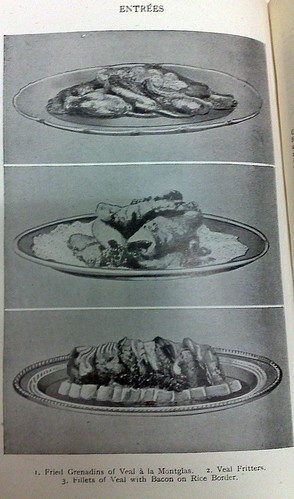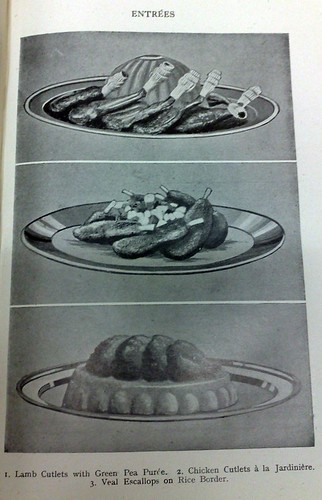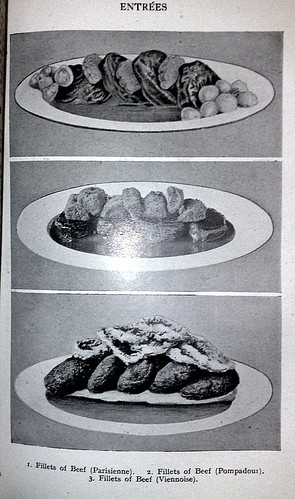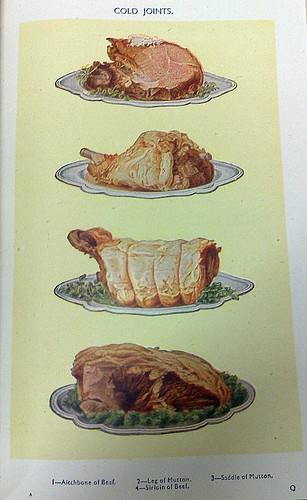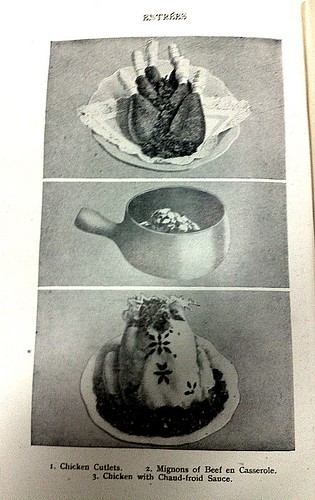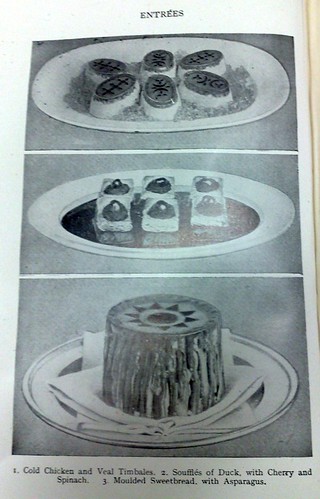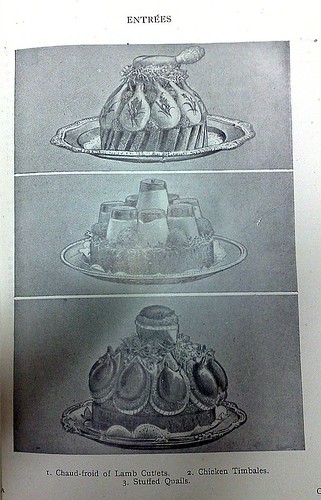Friday, December 25, 2009
It's the most wonderful time of the year!
Wishing you all a very Merry Christmas and a fabulous New Year.
Monday, December 14, 2009
So sue-t me!
 There are all different types of fats involved in cooking. Lard, tallow, suet, duck fat, ghee, butter, oil, olive oil... the list goes on.
There are all different types of fats involved in cooking. Lard, tallow, suet, duck fat, ghee, butter, oil, olive oil... the list goes on.However, essential in a Christmas pudding is suet... which makes finding suet an exciting adventure. Apparently, there can be a big difference between Suet mix and actual suet... but actual suet is a bit thin on the ground here and I haven't located a butcher who will do me up some suet of my own. (Wow, I wonder how many times I can say suet in a sentence? Suet, suet, suet... anyone else think the word suet looks really weird?)
Anyhoo, I've given the old Tandaco Suet mix a burl in my christmas pud. Hopefully it will taste great and not weird. In addition, there are rasins, currants, sultanas, candied peel and lemon rind... and not actually a whole lot more. There's also on interesting recipe for fruitarian pudding (which is without suet) so I may try that one in the future as well.
Tuesday, December 8, 2009
Nine out of ten people like chocolate. The tenth person always lies.
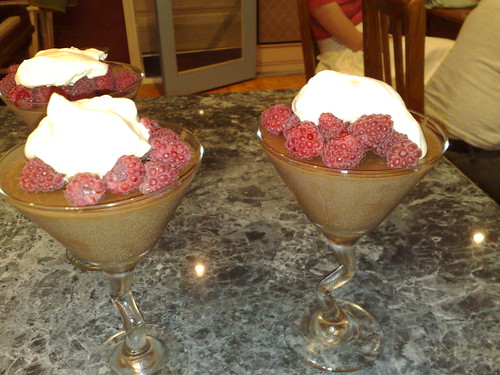
Well, going on the success of my last cream, I thought I'd try another. And what better to try than Chocolate cream, because really - who doesn't love chocolate?
(Now, before you all jump about saying you hate chocolate, I know not everyone loves it... but it sounds poetic, so just let that one through to the keeper. *wink* )
CHOCOLATE CREAM
INGREDIENTS. - 4 oz. of chocolate
2 oz. of castor sugar (that's superfine sugar for you yanks.)
3/4 of an oz. of gelatine
2 yolks of eggs
1/4 a pint of cream
1/4 of a pint of milk
1 teaspoonful of vanilla essence
METHOD. - Simmer the milk and chocolate together until smoothly mixed, let it cool slightly, then add the yolks of eggs and stir until they thicken, but the mixture must not boil or the eggs may curdle.
Dissolve the gelatine in 1 tablespoonful of water, strain it into the custard, and add the vanilla essence.
Whip the cream stiffly, stir it lightly into the custard, turn into a prepared mould, and stand on ice or in a cool place until firmly set.
TIME. - From 20 to 30 minutes. SUFFICIENT for 1 mould.
Can you see what we're making here? It's effectively chocolate mousse but with a less fancy name.
You want to make sure your chocolate mixture is pretty cool when mixing it with the cream, as mine was a bit warm and so my mousse was more solid than it should have been.
Very tasty, but also very rich as I used dark chocolate. Use milk chocolate for a lighter taste.
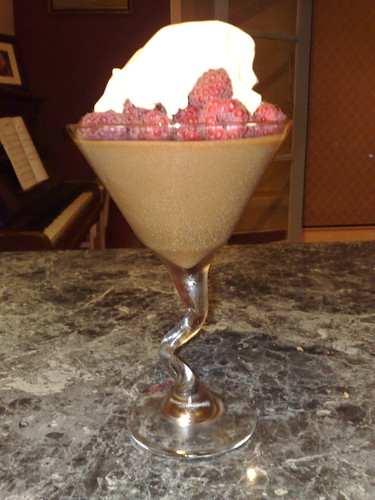
Monday, November 30, 2009
It's a long way to the shop if you wanna sausage roll.
It's a long way to the top if you wanna rock and roll,
and it's a long way to the shop if you wanna sausage roll.
But they're so tasty...nom, nom, nom
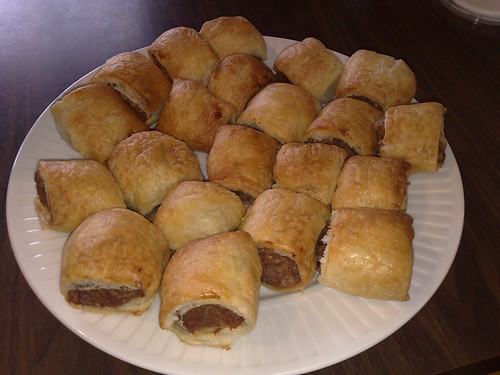
SAUSAGE ROLLS.
INGREDIENTS. - 1/2 a lb of sausages Or you can use sausage mince from the butcher if you prefer.
rough puff pastry
METHOD. - Boil the sausages for about 5 minutes, remove the skins, cut each sausage down and across into 4 pieces, and place them on squares of pastry.
Wet the edges, fold over, leaving the ends open, and bake in a moderate oven.
TIME. - To bake, about 1/2 an hour. SUFFICIENT for about 8 or 9 rolls. Or more if you are making party sausage rolls
and it's a long way to the shop if you wanna sausage roll.
But they're so tasty...nom, nom, nom

SAUSAGE ROLLS.
INGREDIENTS. - 1/2 a lb of sausages Or you can use sausage mince from the butcher if you prefer.
rough puff pastry
METHOD. - Boil the sausages for about 5 minutes, remove the skins, cut each sausage down and across into 4 pieces, and place them on squares of pastry.
Wet the edges, fold over, leaving the ends open, and bake in a moderate oven.
TIME. - To bake, about 1/2 an hour. SUFFICIENT for about 8 or 9 rolls. Or more if you are making party sausage rolls
Tuesday, November 24, 2009
I scream, you scream, we all scream for rice ... pudding.
Rice pudding seems like comfort food to me.
Even though I couldn't tell you one instance where I had it as a child at a particularly trying time or anything.
But it seems like the thing to have.
I did however eat rice cream, which comes in a can, which is effectively what rice pudding is anyway.
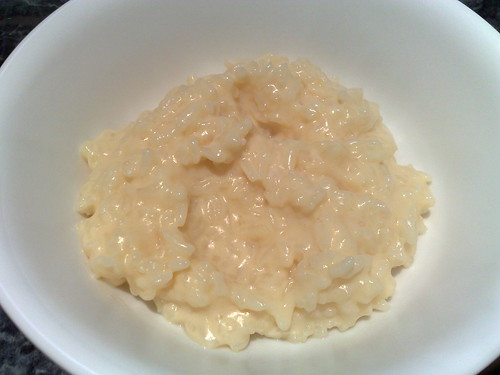
This is not the exact recipe in the book because the book has a baked rice pudding and we all know how well I manage baked custards.
It's also a pretty good way to use up any left over rice you may have. Waste not, want not...and all that jazz.
RICE PUDDING
INGREDIENTS. - Rice (cooked)
1 egg yolk
1/2 a pint of milk
sugar
vanilla essence
METHOD. - Warm the milk and rice together. Do not let the milk boil. Allow to cool a little.
Add beaten egg yolk gradually, stirring to avoid curdling.
Heat on low flame until thick.
Add sugar and vanilla essence to taste.
TIME. - 15 minutes. SUFFICIENT for 2 persons.
Obviously if you have more rice you can add more milk and egg yolks and make more rice pudding which is effectively just vanilla custard with rice in it... go figure.
Even though I couldn't tell you one instance where I had it as a child at a particularly trying time or anything.
But it seems like the thing to have.
I did however eat rice cream, which comes in a can, which is effectively what rice pudding is anyway.

This is not the exact recipe in the book because the book has a baked rice pudding and we all know how well I manage baked custards.
It's also a pretty good way to use up any left over rice you may have. Waste not, want not...and all that jazz.
RICE PUDDING
INGREDIENTS. - Rice (cooked)
1 egg yolk
1/2 a pint of milk
sugar
vanilla essence
METHOD. - Warm the milk and rice together. Do not let the milk boil. Allow to cool a little.
Add beaten egg yolk gradually, stirring to avoid curdling.
Heat on low flame until thick.
Add sugar and vanilla essence to taste.
TIME. - 15 minutes. SUFFICIENT for 2 persons.
Obviously if you have more rice you can add more milk and egg yolks and make more rice pudding which is effectively just vanilla custard with rice in it... go figure.
Tuesday, November 17, 2009
*Raspberries*
Seeing as everyone knows what roast beef looks like, I thought I'd skip straight through to Dessert... although technically it is called the Sweet Entremet as it is a large sweet.
It is also awesomely delicious and the entire thing got eaten save for about 1 spoonful left at the end.
I made 1 portion to begin with, but that was clearly not enough so I made double again (so in total 3 portions)... not only increasing the amount but also giving a pretty two toned effect (I totally meant to do it on purpose ;) )
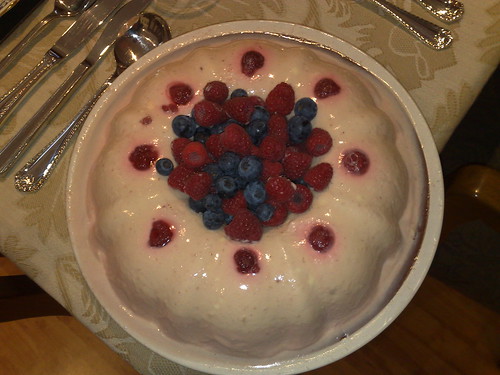

RASPBERRY CREAM.
INGREDIENTS. - 1/2 a pint of cream
1/2 a gill of milk
3/4 oz. of castor sugar
1/4 oz. of gelatine
the juice of 1/2 a lemon
1/2 as gill of raspberry syrup, or 2 dessertspoonfuls of raspberry jam
cochineal
METHOD. - When raspberry jam is used instead of syrup, pass it through a hair sieve, dilute with water to make the required quantity, and add a few drops of cochineal.
Dissolve the gelatine and sugar in the milk, add the lemon-juice, mix with the raspberry syrup, and stir in the stiffly whipped cream.
TIME. - About 1/2 an hour. SUFFICIENT for 1 small mould.
A few notes about this recipe. When adding the lemon-juice (an acid) to the milk/sugar/gelatine mix, wait until it has cooled a little and add it very gradually or else you get lemon milky curds when it curdles. Not so nice... however the lemon juice does add a lovely tang to the cream stopping the dish from being far too cloying and making it delectable. I actually used a Bundt cake pan for my mould and served with fresh raspberries and blueberries. If your cream is sticking too much to the mould, dip it very quickly in hot water... DO NOT LEAVE IT IN THERE FOR ANY LENGTH OF TIME, or else you will melt the cream and get the run-off like you can see in the pictures... Learn from my mistakes.
THIS RECIPE IS DELICIOUS!!!!!!
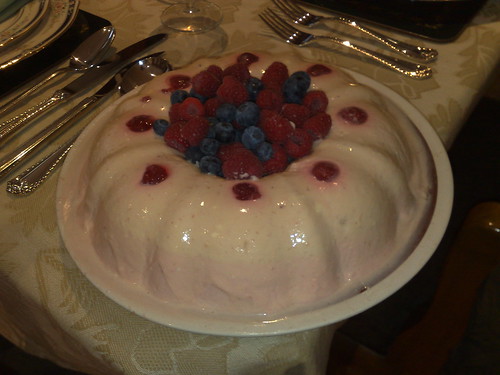
It is also awesomely delicious and the entire thing got eaten save for about 1 spoonful left at the end.
I made 1 portion to begin with, but that was clearly not enough so I made double again (so in total 3 portions)... not only increasing the amount but also giving a pretty two toned effect (I totally meant to do it on purpose ;) )


RASPBERRY CREAM.
INGREDIENTS. - 1/2 a pint of cream
1/2 a gill of milk
3/4 oz. of castor sugar
1/4 oz. of gelatine
the juice of 1/2 a lemon
1/2 as gill of raspberry syrup, or 2 dessertspoonfuls of raspberry jam
cochineal
METHOD. - When raspberry jam is used instead of syrup, pass it through a hair sieve, dilute with water to make the required quantity, and add a few drops of cochineal.
Dissolve the gelatine and sugar in the milk, add the lemon-juice, mix with the raspberry syrup, and stir in the stiffly whipped cream.
TIME. - About 1/2 an hour. SUFFICIENT for 1 small mould.
A few notes about this recipe. When adding the lemon-juice (an acid) to the milk/sugar/gelatine mix, wait until it has cooled a little and add it very gradually or else you get lemon milky curds when it curdles. Not so nice... however the lemon juice does add a lovely tang to the cream stopping the dish from being far too cloying and making it delectable. I actually used a Bundt cake pan for my mould and served with fresh raspberries and blueberries. If your cream is sticking too much to the mould, dip it very quickly in hot water... DO NOT LEAVE IT IN THERE FOR ANY LENGTH OF TIME, or else you will melt the cream and get the run-off like you can see in the pictures... Learn from my mistakes.
THIS RECIPE IS DELICIOUS!!!!!!

Monday, November 16, 2009
Once upon a time there were four little Rabbits, and their names were -- Flopsy, Mopsy, Cotton-tail, and Peter.
The last part of the entrée was a surprise hit. I made it mainly to amuse myself, because after all, what's the point of cooking a fabulous meal if you can't have some fun with it?
But... a surprise hit and consumed by some people who had suggested that it was not something they ate.
It's not actually a Mrs Beeton recipe, but very close to, and similar to a potted meat, of which Mrs Beeton has many recipes. It is essentially a confit of rabbit, shredded and then pressed into a pot/mould.
RABBIT RILLET
INGREDIENTS. - 1 rabbit
duck fat
salt and pepper
sage
METHOD. - Cut the rabbit in to pieces and put in an oven dish. Season with salt and pepper.
Cover with duck fat. (And I really mean, cover, as in submerse)
Confit in an oven at 100oC for about 4 hours.
Drain over a bowl and shred the meat.
Mix with sage and more salt and pepper and then press into a mould or dish.
Cover with saved duck fat from the confit.
Warm before serving.
Warning: Will make your whole house smell like roasting rabbit for hours and can be used as some kind of mental torture for those you live with. Is pretty darn delicious.
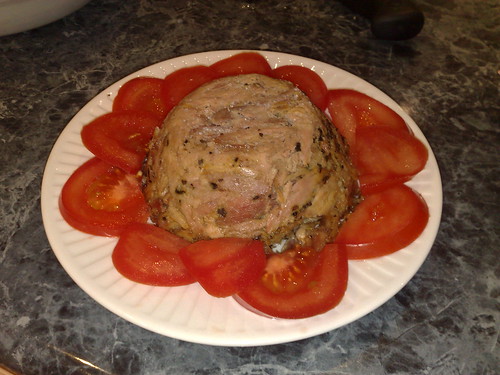
But... a surprise hit and consumed by some people who had suggested that it was not something they ate.
It's not actually a Mrs Beeton recipe, but very close to, and similar to a potted meat, of which Mrs Beeton has many recipes. It is essentially a confit of rabbit, shredded and then pressed into a pot/mould.
RABBIT RILLET
INGREDIENTS. - 1 rabbit
duck fat
salt and pepper
sage
METHOD. - Cut the rabbit in to pieces and put in an oven dish. Season with salt and pepper.
Cover with duck fat. (And I really mean, cover, as in submerse)
Confit in an oven at 100oC for about 4 hours.
Drain over a bowl and shred the meat.
Mix with sage and more salt and pepper and then press into a mould or dish.
Cover with saved duck fat from the confit.
Warm before serving.
Warning: Will make your whole house smell like roasting rabbit for hours and can be used as some kind of mental torture for those you live with. Is pretty darn delicious.

Friday, November 13, 2009
It was... THE SALMON MOUSSE!!!
Just a little Monty Python for you readers out there...
Also for entrée was Salmon Mousse. This is not to be found in All About Cookery, so we will have to repair to the 70's (which perhaps is a better place for salmon mousse to reside) and Mrs Beeton's Simple Cookery in Colour for the recipe. Please note the tasty fish aspic that also surrounds my salmon mousse...
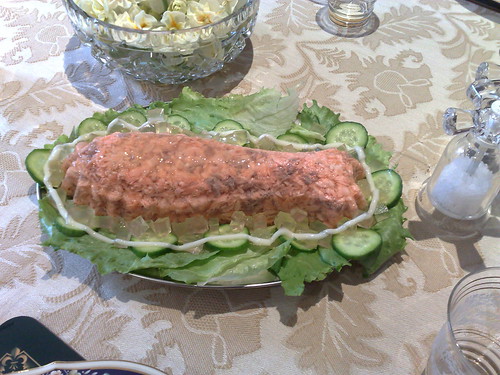
SALMON MOUSSE
INGREDIENTS. - 1/2 lb of cooked salmon or 1 X 7 3/4 oz. can of salmon
1/2 oz. of powdered gelatine
1/2 a pint of fish stock
salt and pepper
1/4 of a cucumber, sliced
A few slices of tomato
METHOD. - Drain the oil from the canned salmon, and take out any skin and bones. Mash the fins in a basin.
Sprinkle the gelatine on the fish stock, to soften it. Season it. Then heat the stock gently, stirring it, until the gelatine melts; a spoonful will then be clear, without specks.
Rinse the inside of a china souffle dish or cake tin with cold water. Pour in a thin layer of the stock, and let it set.
Arrange cucumber slices on the set jelly in a pattern. Very gently, pour a little more stock over them. Let this set too.
Add a layer of salmon, press it down gently with a fork, cover with stock and leave to set once more. Repeat this process until you have used all the salmon and stock. (If the stock looks like setting, warm it a little)
Keep the mousse in a refrigerator or somewhere cool until you want to use it. Then turn it out. Run a sharp knife round the sides of the dish, to loosen the mousse.
Put a serving dish upside down on top of the dish. Turn the dish and plate over together, and jerk them to dislodge the mousse. (If it will not come out easily, hold a hot wet cloth over the dish for a moment.)
Decorate with cucumber and tomato.
3-4 helpings.
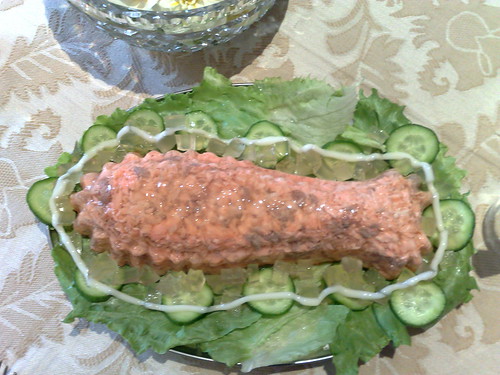
Or use a fish mould which is way cooler... pretty yummy although a little too gelatinous for me... and definitely too much left over stock - hence the fish aspic...
Also for entrée was Salmon Mousse. This is not to be found in All About Cookery, so we will have to repair to the 70's (which perhaps is a better place for salmon mousse to reside) and Mrs Beeton's Simple Cookery in Colour for the recipe. Please note the tasty fish aspic that also surrounds my salmon mousse...

SALMON MOUSSE
INGREDIENTS. - 1/2 lb of cooked salmon or 1 X 7 3/4 oz. can of salmon
1/2 oz. of powdered gelatine
1/2 a pint of fish stock
salt and pepper
1/4 of a cucumber, sliced
A few slices of tomato
METHOD. - Drain the oil from the canned salmon, and take out any skin and bones. Mash the fins in a basin.
Sprinkle the gelatine on the fish stock, to soften it. Season it. Then heat the stock gently, stirring it, until the gelatine melts; a spoonful will then be clear, without specks.
Rinse the inside of a china souffle dish or cake tin with cold water. Pour in a thin layer of the stock, and let it set.
Arrange cucumber slices on the set jelly in a pattern. Very gently, pour a little more stock over them. Let this set too.
Add a layer of salmon, press it down gently with a fork, cover with stock and leave to set once more. Repeat this process until you have used all the salmon and stock. (If the stock looks like setting, warm it a little)
Keep the mousse in a refrigerator or somewhere cool until you want to use it. Then turn it out. Run a sharp knife round the sides of the dish, to loosen the mousse.
Put a serving dish upside down on top of the dish. Turn the dish and plate over together, and jerk them to dislodge the mousse. (If it will not come out easily, hold a hot wet cloth over the dish for a moment.)
Decorate with cucumber and tomato.
3-4 helpings.

Or use a fish mould which is way cooler... pretty yummy although a little too gelatinous for me... and definitely too much left over stock - hence the fish aspic...
Tuesday, November 10, 2009
Monday, November 9, 2009
Cannelons, not Cannelloni
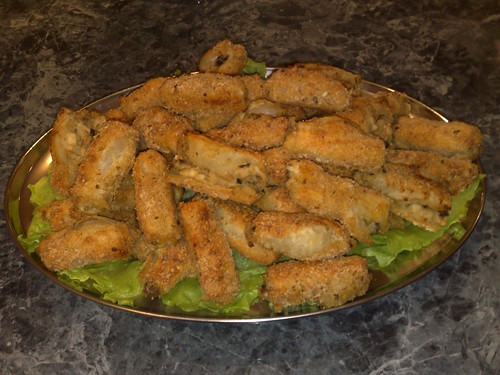 I've been writing this post for about 2 weeks and keep getting interrupted because I know you're all just dying to know about the rest of my dinner party.
I've been writing this post for about 2 weeks and keep getting interrupted because I know you're all just dying to know about the rest of my dinner party.Anyway, here are the entrées -
CHICKEN CANNELONS
INGREDIENTS. - Chicken croquette mixture
rough puff-paste
egg
breadcrumbs
fat
parsley
METHOD. - Roll out the paste as thinly as possible, and cut it into 1 1/4 or 1 1/2 inch squares.
Place a little of the chicken mixture in the centre of each square, and roll up rather tightly.
Coat them carefully with egg and breadcrumbs, fry in hot fat until lightly browned, then drain well, and serve garnished with sprigs of crisply-fried parsley.
TIME. - To fry, about 5 minutes. SUFFICIENT, allow 2 cannelons to each person.
CHICKEN CROQUETTES.
INGREDIENTS. - 6 to 8 oz. of cold chicken or fowl (boned)
2 oz. of cooked ham or tongue
1/4 of a pint of stock
1 oz. of butter
1 oz. of flour
1 tablespoonful of cream or milk
1 teaspoonful of lemon-juice
6 button mushrooms
1 truffle
salt and pepper
egg
breadcrumbs
fat (these last three ingredients are for if you actually want to make the croquettes)
METHOD. - Chop the chicken and ham or tongue finely, cut the mushrooms and truffle into small pieces. As I had several people who don't eat pork I just used more chicken. Also truffles are worth their weight in gold here so I used more mushrooms and covered them in truffle oil. Sue me.
Melt the butter, fry the flour without browning, add the stock, and cook well. Stir in the chicken, ham or tongue, cream or milk, lemon-juice, mushrooms and truffle, season with salt and pepper, and turn on a plate to cool.
Make into cork-shaped croquettes, coat carefully with egg and breadcrumbs, and fry until lightly browned in hot fat.
TIME. - About 1 hour. SUFFICIENT for about 6 persons.
This recipe is very delicious. I think it works better though if you make sausage roll sized cannelons, because it is less fiddle than the 1 inch ones... would be great for an afternoon tea.
Friday, October 23, 2009
Fly away on my Zephyr
zephyr (plural zephyrs)
1. a light wind from the west
2. any light refreshing wind; a gentle breeze
3. any thing of fine, soft, or light quality, especially fabric
Strangely, I cannot find zéphire(s) in the dictionary so I'm just going with zephyr, and considering cheese zéphires are made with whipped cream it probably fits. I thought they were a touch boring on their own but served on garlic toasts with a bit of tomato, quite yum.
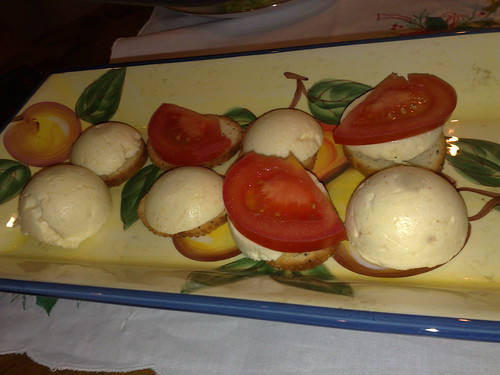
CHEESE ZÉPHIRES.
INGREDIENTS. - 3 heaped tablespoonfuls of Parmesan cheese
1 oz. of gelatine
1/2 a pint of cream
1/2 a pint of milk
cayenne
salt
METHOD. - Soak the gelatine in the milk for about 1/2 an hour, then stir it over the fire until it is dissolved.
Let it cool, add the cheese, the cream previously stiffly whipped, and seasoning to taste.
Turn into oval fluted zéphire moulds, set on ice until firm, then unmould, and serve garnished with chopped aspic jelly and shredded truffle and pimiento.
TIME. - About 4 hours. SUFFICIENT for 6 or 7 persons.
And I'm not sure what a zéphire mould is either, I just used a round cupcake pan to get some cute little domes.
1. a light wind from the west
2. any light refreshing wind; a gentle breeze
3. any thing of fine, soft, or light quality, especially fabric
Strangely, I cannot find zéphire(s) in the dictionary so I'm just going with zephyr, and considering cheese zéphires are made with whipped cream it probably fits. I thought they were a touch boring on their own but served on garlic toasts with a bit of tomato, quite yum.

CHEESE ZÉPHIRES.
INGREDIENTS. - 3 heaped tablespoonfuls of Parmesan cheese
1 oz. of gelatine
1/2 a pint of cream
1/2 a pint of milk
cayenne
salt
METHOD. - Soak the gelatine in the milk for about 1/2 an hour, then stir it over the fire until it is dissolved.
Let it cool, add the cheese, the cream previously stiffly whipped, and seasoning to taste.
Turn into oval fluted zéphire moulds, set on ice until firm, then unmould, and serve garnished with chopped aspic jelly and shredded truffle and pimiento.
TIME. - About 4 hours. SUFFICIENT for 6 or 7 persons.
And I'm not sure what a zéphire mould is either, I just used a round cupcake pan to get some cute little domes.
Tuesday, October 20, 2009
The devil is in the detail
Angels on Horseback and Devils on Horseback - which is which? You guess. Angels on Horseback are actually a 'savoury' in Mrs Beeton which would therefore come at the end of the meal. But seeing as we are not really in the habit of eating more after the sweets, I decided to make them as an Hors d'œuvre instead.
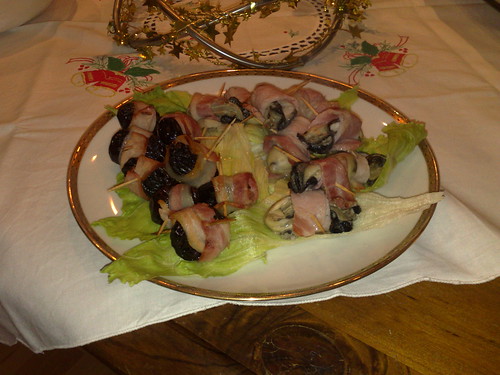
"ANGELS ON HORSEBACK"
INGREDIENTS. - 12 oysters
12 small thin slices of bacon
12 small round croûtes of bread
1/2 a teaspoon of finely-chopped shallot
1/2 a teaspoon of finely-chopped parsley
a little lemon juice
Krona pepper
METHOD. - Beard the oysters, trim the bacon, cutting each piece just large enough to roll round an oyster, season with Krona pepper, sprinkle on a little shallot and parsley.
Lay an oyster on each, add a few drops of lemon-juice, roll up tightly, and secure the bacon in position with a large pin.
Fry in a frying-pan or bake in a hot oven just long enough to crisp the bacon (further cooking would harden the oyster), remove the pins and serve on the croûtes.
TIME. - About 20 minutes. SUFFICIENT for 8 or 9 persons.
If you are planning on serving these at a party, baking needs less attention allowing you to enjoy more time with your guests. I left my pins (or toothpick in this case) in for ease of serving and eating when hors d'œuvring.
"DEVILS ON HORSEBACK."
INGREDIENTS. - 12 prunes
12 small thin slices of bacon
12 small round croûtes of bread
1/2 a teaspoon of finely-chopped shallot
1/2 a teaspoon of finely-chopped parsley
Krona pepper
METHOD. - Trim the bacon, cutting each piece just large enough to roll round an oyster, season with Krona pepper, sprinkle on a little shallot and parsley.
Lay a prune on each, roll up tightly, and secure the bacon in position with a large pin.
Fry in a frying-pan or bake in a hot oven just long enough to crisp the bacon and warm the prune, remove the pins and serve on the croûtes.
TIME. - About 20 minutes. SUFFICIENT for 8 or 9 persons.
These are also pretty tasty, but remember they still have a pip in them (being dried plums) so have a little bowl or something to receive the pips.

"ANGELS ON HORSEBACK"
INGREDIENTS. - 12 oysters
12 small thin slices of bacon
12 small round croûtes of bread
1/2 a teaspoon of finely-chopped shallot
1/2 a teaspoon of finely-chopped parsley
a little lemon juice
Krona pepper
METHOD. - Beard the oysters, trim the bacon, cutting each piece just large enough to roll round an oyster, season with Krona pepper, sprinkle on a little shallot and parsley.
Lay an oyster on each, add a few drops of lemon-juice, roll up tightly, and secure the bacon in position with a large pin.
Fry in a frying-pan or bake in a hot oven just long enough to crisp the bacon (further cooking would harden the oyster), remove the pins and serve on the croûtes.
TIME. - About 20 minutes. SUFFICIENT for 8 or 9 persons.
If you are planning on serving these at a party, baking needs less attention allowing you to enjoy more time with your guests. I left my pins (or toothpick in this case) in for ease of serving and eating when hors d'œuvring.
"DEVILS ON HORSEBACK."
INGREDIENTS. - 12 prunes
12 small thin slices of bacon
12 small round croûtes of bread
1/2 a teaspoon of finely-chopped shallot
1/2 a teaspoon of finely-chopped parsley
Krona pepper
METHOD. - Trim the bacon, cutting each piece just large enough to roll round an oyster, season with Krona pepper, sprinkle on a little shallot and parsley.
Lay a prune on each, roll up tightly, and secure the bacon in position with a large pin.
Fry in a frying-pan or bake in a hot oven just long enough to crisp the bacon and warm the prune, remove the pins and serve on the croûtes.
TIME. - About 20 minutes. SUFFICIENT for 8 or 9 persons.
These are also pretty tasty, but remember they still have a pip in them (being dried plums) so have a little bowl or something to receive the pips.
Monday, October 19, 2009
The secret to staying young is to live honestly, eat slowly, and lie about your age.
Well, I had a birthday recently. And for said birthday I had a dinner party of almost Herculean standards. Well for me anyway. It was a "How to host a Murder" Party set at a movie premiere in 1936.
So naturally I go way overboard with the cooking but it was all in good fun.
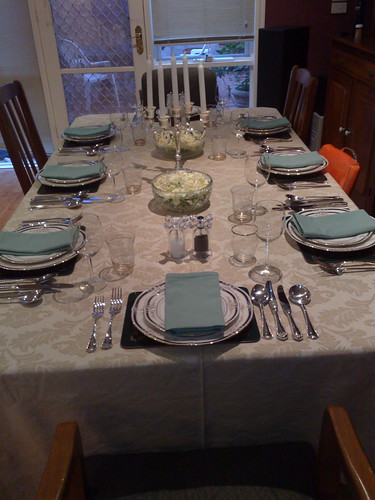
Here is my table all beautifully set. I polished the silver myself as it's so hard to get good staff these days. I even measured my table to ensure everyone had the required 24". It required 1 extra leaf in my table, just to seat 8. And an appropriate use flowers to follow the colour scheme. I think it's pretty if I do say so myself.
So to a brief overview of the menu then.
Hors d'œuvres
Oysters au Naturel
Cheese Zephires
Angels on Horseback
Devils on Horseback
Soup
Clear Julienne Soup
Entrées
Chicken Cannelons
Salmon Mousse
Rabbit Rillet
Main
Roast Beef
Roast Potatoes confit in Duck fat
Asparagus
Carrots
Peas
Gravy
Sweets
Raspberry Cream
Cake
Ingrid's Chocolate cake
And now on to some recipes:
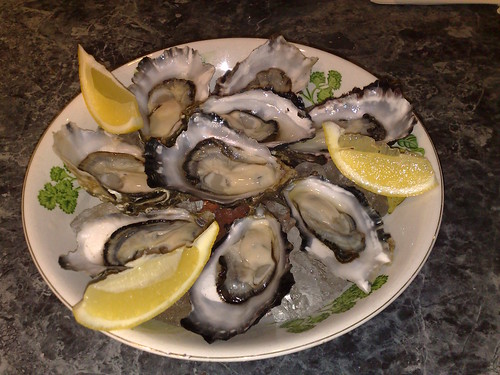
OYSTERS AU NATUREL.
There are many ways of dressing oysters, either hot or cold, but only one way of serving them, "au naturel," which is considered the most popular hor's dœurve. Only the best kinds, natives - Whitstable or Colchester oysters, should be served "au naturel," i.e., raw. All the need, after being opened, is to be placed on the upper shell with a little of the liquor; they are then ranged on a dish, garnished with sprigs of fresh parsley, and if possible, surrounded with shaved ice.
Some thin slices of buttered brown bread, and quarters of lemon are handed round at the same time; also Nepaul or cayenne pepper.
I have to confess I didn't check to see if my oysters were Whitstable or Colchester but they were yummy none the less. I substitued those garlic toast biscuits instead of the buttered brown bread.
So naturally I go way overboard with the cooking but it was all in good fun.

Here is my table all beautifully set. I polished the silver myself as it's so hard to get good staff these days. I even measured my table to ensure everyone had the required 24". It required 1 extra leaf in my table, just to seat 8. And an appropriate use flowers to follow the colour scheme. I think it's pretty if I do say so myself.
So to a brief overview of the menu then.
Hors d'œuvres
Oysters au Naturel
Cheese Zephires
Angels on Horseback
Devils on Horseback
Soup
Clear Julienne Soup
Entrées
Chicken Cannelons
Salmon Mousse
Rabbit Rillet
Main
Roast Beef
Roast Potatoes confit in Duck fat
Asparagus
Carrots
Peas
Gravy
Sweets
Raspberry Cream
Cake
Ingrid's Chocolate cake
And now on to some recipes:

OYSTERS AU NATUREL.
There are many ways of dressing oysters, either hot or cold, but only one way of serving them, "au naturel," which is considered the most popular hor's dœurve. Only the best kinds, natives - Whitstable or Colchester oysters, should be served "au naturel," i.e., raw. All the need, after being opened, is to be placed on the upper shell with a little of the liquor; they are then ranged on a dish, garnished with sprigs of fresh parsley, and if possible, surrounded with shaved ice.
Some thin slices of buttered brown bread, and quarters of lemon are handed round at the same time; also Nepaul or cayenne pepper.
I have to confess I didn't check to see if my oysters were Whitstable or Colchester but they were yummy none the less. I substitued those garlic toast biscuits instead of the buttered brown bread.
Sunday, October 18, 2009
How much of human life is lost in waiting.

HOW TO WAIT AT TABLE
ORDER AND ROUTINE.
The waiting commences from the head of the table, and there must be assistants, outside the door, to bring the dishes and remove them entirely from the room. When the dinner is served on the table the attendant must stand at the left-hand side of the carver, and remove the covers. As the soup comes first, a plateful is carried to each person, unless they signify they do not wish for any, and commences from the one on the right of the host. The sherry or claret is then handed round. At a large gathering the moment a person's plate is empty, or finished with, it must be quietly taken away, spoon and all, but when the party is only a small one, the plates are usually left until all have finished the course. In any case, the plates of the host and hostess are always left till last. At informal parties guests should be asked if they wish for a second helping, but not at formal gatherings. Never remove a dish which is being served until all have finished that course. The fish is carried round in the same manner as the soup, the attendant having in the left hand the sauce-boat, or being followed by another servant carrying it. All plates are placed by the attendant at the left-hand side of the person being served, and when used removed from the left or right. Entrées are invariably handed even when the joints are carved upon the table. When the joint comes on, and the meat has been taken to the guests as before, the vegetables (which are usually placed upon the sideboard, and not on the table) are handed about, together with a sauce-boat of gravy for fowls or birds. As soon as all have been served with the meat course the wines are again handed round. The meat course finished, the soiled plates are removed, and the sweet course, followed by the savoury, is brought in. Dinner over, the unused cutlery, the glass, cruets and carving cloth are brushed away from the guests' left-hand side; the dessert-plates, finger bowls and port glasses are arranged upon the table; and after everything is in proper order, the port and a few dishes are handed round by the attendants. who then leave the room. In handing aerated waters, lemonade, etc., the attendant takes the small tray or salver in the left hand and, standing on the left side of the guest who places his or her glass upon it, pours out the required liquid with the right hand. When clean knives and forks are required, they must be placed on the table and not handed on the salver.
At hospitality school we learnt to serve from the right and clear from the left... I wonder which is the more "correct" way or if it has changed over the years?
Dishes should be handed at a convenient level: they are usually served too high and not far enough forward. They should be served with the left hand, the body turned a little to the right. If the right hand be free do not rest it on the back of the chair.
Heaven forbid your wait staff should get overly familiar with your guests and dare to touch their chair.
Saturday, October 17, 2009
Hope is a good breakfast, but it is a bad supper.

FAMILY SUPPERS.
At these, food of a light description should be served, and to make these meals enjoyable the dishes should be as varied as possible. Fish re-dressed in the form of mayonnaises, croquettes, or pies, can easily be made into a good supper dish; the remains of poultry or game hashed make a tempting and savoury one where hot dishes are liked, and all kinds of odds and ends can, with a little ingenuity, be utilized to form more appetising food at supper time than perpetual cold meat. Salad or cucumber should not be wanting at the family meal in summer, when such things are plentiful and cheap, while in winter a few cold potatoes friend make a nice addition, or a well-made potato salad. As with breakfast dishes, those for supper are more a question of trouble and time than cost.
Friday, October 16, 2009
You can't fake quality any more than you can fake a good meal.
 TO LAY THE CLOTH FOR DINNER.
TO LAY THE CLOTH FOR DINNER.The cloth itself must first be put on straight and evenly, and if at all creased should be pressed with a clean iron over a damp cloth. The cloth should not be laid upon the bare table, but the table should be first covered by some asbestos-felt or an old cloth. Should the housewife wish to display her highly-polished table, she may dispense with a table-cloth and use dainty lace mats for each plate or dish, taking care to protect the polish of the table by using small asbestos mats under the fancy mats.
Here we go with the asbestos again. I believe all of my place mats are cork backed, so I hope that suffices.
Everything necessary for laying the cloth, including the napkins, should first be brought into the room, and it is a good plan to put the latter round the table first, so that the same amount of space can be allowed to each person.
Remember we're giving each person AT LEAST 24 inches. Except at a lot of restaurants where they really don't seem to care if you keep nudging the person next to you when cutting your steak.
These occupy the space between the knives and forks, and in each, if folded, should be put either a dinner roll or a piece of bread cut rather thick.
Remembering of course that side plates are a definite no-no at dinner.
Table-napkins are often merely folded over and laid flat on the plate ready for the hors d'œuvre, between the knives and forks; a small knife is then laid on the napkin.
Next place the menu cards, if these are used, either one to each person, or one between three or four, if only a few are provided.
The water jugs, cruets and salt cellars may next be laid. There should be a cruet at each corner of the table, while a salt cellar should be between every two persons. We now come to the knives and forks, and of these it is usual to lay a large one of each, the knife flanked to the right by a fish knife, a soup spoon, and an hors d'œuvre fork, and on the left of the fork should be the fish fork; other knives and forks are supplied with the plates for different courses.
A cruet set is a collection of little bottles of vinegar and oil and pepper... sometimes salt as well.
The question of what wine is to be drunk at dinner will determine what glasses are wanted, as the glasses used for dessert are put on afterwards.
Supposing, as is so often the case, sherry, champagne and claret are to be served, put the proper glasses for each to the right side of each person, setting them in a triangle, with the sherry glass (the first used) at the top, just reaching to the point of the knife, but at a convenient distance from it.
Exactly the same way we were taught to put glasses on the table at hospitality school. Some things never change.
The sideboard requires to be laid as carefully as the dinner-table itself, and everything that can be put there ready for placing on the table afterwards, such as finger-bowls, glasses for dessert wine, dessert plates, decanters, and knives, forks and spoons of every kind should be there ready and carefully arranged. The decanters, salvers, glasses, etc., should be put well at the back of the sideboard, and the plates, knives, forks, etc., neatly laid in front.
When the dinner is not carved on the table, one specially intended for the carver should be prepared with carving knives and forks (the former carefully sharpened beforehand) of various kinds, soup ladle, fish-carvers, etc., in the order of serving the dinner, that nothing may delay him when he commences his duties.
I always, always, always carve in the kitchen. I don't know why, but it seems easier somehow, and I always make a big mess which would probably ruin my table cloth.
Champagne, hock, or other sparkling wines that are only uncorked when wanted, may find a place under the sideboard of side tables where the ice pails are to be found; decanted wines are put on the sideboard.
Tuesday, October 13, 2009
After a good dinner one can forgive anybody, even one's own relations.
 DINNER.
DINNER.When dinner is placed upon the table, if there is only on chief dish place it at the head of the table. If two, one to the host and one to the hostess. If three, one (the principle) at the head and the other two together near the bottom. If four, the two principle at top and bottom, the others at the sides. Six dishes can be arranged as for four. Seven will require three dishes down the middle of the tale and two on either side.
To be honest, I think I just plonk 'em down wherever they will fit. My bad...
Courses. - The order of the courses of a modern dinner should be as follows: the soup is usually preceded by an Hors 'dœvre, such as caviare, croûtons, sardines, oysters, or other little appétissants.
The First Course is usually soup, the second fish, then comes the entrées (made dishes). The next Course, joints, then poultry and game, and after these sweets, then savory dishes, then cheese and celery. When there are two roast meats they should be opposite colours, i.e., not two whites or two browns. Entrées require care in handling; there is nearly always gravy with them, and this must not be upset upon the cloth. The last arrangement of dishes - which cannot be called a course, seeing that the dinner is virtually over - the dessert comprises tastefull arranged fruits that are most in season.
Following is a specimen menu:-
SPECIMEN MENU FOR A DINNER
FRENCH
Potage.
Consommé a la Colbert
Poisson.
Turbot bouilli
Sauce aux Huîtres.
Entrée.
Filet de Bœuf à la Brillat
Tomate farcies à l'Italienne
Rôti.
Faisan bardé au Cresson.
Salase de Saison. Pommes frites.
Entremets.
Omelette à la Célestine.
Gelée aux Bananes.
Bonne Bouche.
Buissone d'Ecrevisse.
Dessert.
ENGLISH
Soup.
Clear Soup with Poached Eggs.
Fish.
Boiled Turbot. Oyster Sauce
Entrée.
Braised Fillet of Beef.
Stuffed Tomates.
Roast.
Roast Pheasant with Cress.
Chipped Potatoes. Salad.
Sweets.
Omelet with Preserved Fruit.
Banana Jelly.
Savoury.
Dressed Prawns.
Dessert.
I always just assumed sweets and dessert were meant to be the same thing and people were just being pretentious. However, it is evident in this context that they are completely different things. It also makes my 6 course meal into only 4 courses, because Hors d'œurves don't count as a course... and I would imagine neither does cake.
In giving a dinner it is far better to have a simple meal, which one knows will be properly cooked and serves, than to risk anything elaborate, for it is difficult to appear utterly unconcerned when one is harassed by petty cares, and a thoroughly good hostess is one who is able herself to enjoy, without anxiety, the dinner she is giving.
This is by far and away the most important point I think in the whole chapter. Emily Post also agrees that it is better to have a good simple meal than a bad elaborate one. Also on this note, it is hard to enjoy oneself with a giant burn on ones' hand as happened at a recent dinner of mine and put a pretty big dampner on the whole evening.
The temperature of the room is a very important subject that is often overlooked. It is not possible thoroughly to enjoy a good dinner in a room either too hot or too cold.
Particularly a hot cooked Christmas dinner on a 44oC day in Australia.
Monday, October 12, 2009
Tuesday, October 6, 2009
I'm flattered
Well, I'm honoured to receive the Kreativ Blogger award.

The "RULES" of this award are that I am to:
1) tell you seven things that you don't already know about me.
2) I am to name seven other blogs to receive this award.
3)I am to leave a comment on each of the blogs I have nominated letting them know that I have given them an award.
4) And lastly, I am to thank the blog that you gave me the award.
seven things you may not know about me...
1) I have a small piece of gravel in my forehead. Long story short, don't do hurdles on the gravel yard.
2) I love sewing, but HATE HATE HATE cutting out so I have a large pile of material and patterns all waiting for the scissors faries to do their magic
3) I'd love to flounce around in my house in a BIG crinoline, but I don't think I'd fit down the hallways.
4) I have an unnatural interest in English history. No seriously... apparently it's not the current fad at Australian Universities
5) I have Dutch heritage which I like to exploit by wearing clogs and plaits and riding a bicycle... also eating olle bollen, croquettes and other fried foods
6) I was scared away from the local SCA group because when I went past their stall at 'O' week at uni there was a very large lady with a distrubingly large amount of bosom on show
7) I am always surprised that there are people interested in reading my blog
There are a heap of great blogs that I love but here are just a few that I nominate for this award:
1) Jitterbug at Destination 1940
2) Trixie at That's just stupid what you said
3) Vintage Verve at Vintage Verve
4) LaPetiteMort at LaPetiteMort
5) Roxanne at The Haven of Home
6) Packrat at Swatting at flies
7) Lolita Haze at Vintage Starlet
Many thanks to Wearing History for the nomination

The "RULES" of this award are that I am to:
1) tell you seven things that you don't already know about me.
2) I am to name seven other blogs to receive this award.
3)I am to leave a comment on each of the blogs I have nominated letting them know that I have given them an award.
4) And lastly, I am to thank the blog that you gave me the award.
seven things you may not know about me...
1) I have a small piece of gravel in my forehead. Long story short, don't do hurdles on the gravel yard.
2) I love sewing, but HATE HATE HATE cutting out so I have a large pile of material and patterns all waiting for the scissors faries to do their magic
3) I'd love to flounce around in my house in a BIG crinoline, but I don't think I'd fit down the hallways.
4) I have an unnatural interest in English history. No seriously... apparently it's not the current fad at Australian Universities
5) I have Dutch heritage which I like to exploit by wearing clogs and plaits and riding a bicycle... also eating olle bollen, croquettes and other fried foods
6) I was scared away from the local SCA group because when I went past their stall at 'O' week at uni there was a very large lady with a distrubingly large amount of bosom on show
7) I am always surprised that there are people interested in reading my blog
There are a heap of great blogs that I love but here are just a few that I nominate for this award:
1) Jitterbug at Destination 1940
2) Trixie at That's just stupid what you said
3) Vintage Verve at Vintage Verve
4) LaPetiteMort at LaPetiteMort
5) Roxanne at The Haven of Home
6) Packrat at Swatting at flies
7) Lolita Haze at Vintage Starlet
Many thanks to Wearing History for the nomination
Game on, Elizabeth David...

I recently had a birthday, and for said birthday a lovely family friend gave me a cookery book (everyone seems to have picked up on my exciting new-ish obsession for cookery books...).
I got Elizabeth David's French Provincial Cooking, first published in 1960.
Elizabeth David is considered responsible for bringing French and Italian cooking into the British home (along with now ubiquitous items such as olive oil and the courgette). In a Britain worn down by post-war rationing and dull food, she celebrated the regional and rural dishes of the Mediterranean rather than the fussier food of the gourmands and aristocrats. David's style is characterised by terse descriptions of the recipes themselves, accompanied by detailed descriptions of their context and historical background, and often laced with anecdotal asides. She was often scathing of bad food, including much of the food of England that she and her readers had grown up with.
I used her book in conjunction with Mrs Beeton for one dish of my latest and greatest dinner party, so I was most distressed to read this quote from her.
"If I had been given a standard Mrs Beeton instead of Mrs Leyel's wonderful recipes," she said, "I would probably never have learned to cook."
I find it endlessly interesting that a woman who was born in 1913 and was given her first cook book age 19 (The Gentle Art of Cookery by Hilda Leyel) saw Mrs Beeton as the epitome of boring and bland British Cookery, whereas I, born 70 years later, find Mrs Beeton inhabiting a fascinating world of interesting ingredients and ideas. Things that were common place for Mrs Beeton and for Ms David are strange and unusual for me. And no doubt things that are ordinary for me would be bewildering for Mrs Beeton or anyone else of that era.
Anyway, I'll not hold Ms David's poor opinion of Mrs Beeton against her, as really... she didn't know any better.
Tuesday, September 29, 2009
It is more fun to talk with someone who doesn't use long, difficult words but rather short, easy words like "What about lunch?" - Winnie the Pooh
 LUNCHEONS.
LUNCHEONS.Luncheon Dishes. - Ordinary luncheons, as a rule, have fewer courses than dinner, but in other respects they are almost identical, and may comprise hors d'oeurves, soup, fish, meat, poultry or game, sweets and savouries. Hors d'ourves are almost invariably served as a preliminary; either soup or fish is frequently omitted, and the sweets provided are of a comparatively simple characters, such as soufflés, milk puddings, fruit tarts, compôte of fruit, etc. A joint of meat, a fruit tart or stewed fruit, or a suet or milk pudding, constitute the luncheon of many who dine late, more especially when the household includes children who share the midday meal. Or the luncheon may consist of the cold remains of the previous night's dinner, in which case parts of birds, tarts, creams, jellies, etc., are usually made more presentable by being cut into portions suitable for serving, and neatly arranged on a dish.
The Service of Luncheon varies considerably, for while luncheon à la Russe may be said to predominate in fashionable circles, yet a very large number of people still follow the older custom of having all the hot dishes placed upon the table.
The table arrangements for luncheons served à la Russe are the same as for dinner, the centre of the table being occupied by nothing but fruit, flowers, cruets, and other articles used in the service. Under any circumstances, each cover should comprise one large and one small knife, a fork, and a small fork for the hors d'oeuvre, but the old custom of placing a small fork and dessertspoon is no longer followed, except at informal meals. When fish is included in the menu, the knife and fork provided for its service must be laid to the right and left, on the outside of those already on the table, and if soup is to be served, a soup spoon or a tablespoon must be placed to the right, outside the fish knife. According to present fashion, the maximum alllowed to each cover is two knives and two forks, one fish knife and fork, and one soup spoon, all of which should be placed a quarter inch from each other and one inch from the edge of the table. When the dishes are placed upon the table, instead of being served à la Russe, each dish to be carved must be accompanied by appropriate carving-knives and forks, and each entrée, or sweet, by a tablespoon and fork. The wine to be served will determine the number of glasses to be used. If, say, claret, hock and minerals are selected, then tumblers, hock and claret glasses should be provided; but glasses should never appear on the table unless the wine to which they are appropriate is to be served.
Table-napkins should be placed in the space between the knives and forks.
Friday, September 25, 2009
Breakfast is the most important meal of the day. It's unbelievably important. You should eat breakfast at least three times a day.
BREAKFASTS.
Breakfast Dishes. - The moral and physical welfare of mankind depends largely on its breakfast, yet many of those upon whom the responsibility of providing it rests do not realize how far-reaching may be the effects of a good or bad meal. A being well fed and warmed is naturally on better terms with himself and his surroundings than one whose minds and body are being taxed by the discomfort and annoyance of badly cooked or insufficient food. In small households there is a constant complaint of lack of variety, and the too frequent appearance of bacon and eggs, which, it must be confessed, is the sheet-anchor of the English cook.
But, notwithstanding this plea for "something new", there are over two hundred ways of dressing eggs, to say nothing of grilled chops, steaks, cutlets, kidneys, fish and mushrooms, anchovy and sardine toast, sausage rolls, sausages grilled, boiled or fried, meat patties, rissoles, croquettes and croûtes, fish omelet, fish-cakes, fish soused and kedgeree, pressed beef, galantine of beef, potato chips, potatoes fried in a variety of ways, and a host of other inexpensive and easily-prepared dishes. Many housewives cannot, of course, afford to provide some of the dishes enumerates above, but the present work includes an almost endless variety of preparations of a simple characters, which might be advantageously used to relieve the monotony of breakfast.
Which all makes perfect sense. Breakfast is very important, and if you end up eating the same cereal over and over again, it can quickly grow dull and unappealing.
The Service of Breakfast varies very little, no matter how simple or elaborate the meal. On the cottage table, the breakfast-ware, teapot, bread, butter, and dish of bacon, or whatever constitutes the homely fare, all have their allotted places, although the arrangement of the respective articles may not agree with everybody's sense of fitness. When the table is a small one, the centre of it may be occupied by a single vase of flowers, or bowls of flowers placed equidistant from each other may form the decoration of a larger table. Other appointments depends on the number of persons to be seated and the dishes to be served. When the meal consists of one dish, a knife and fore, either large or small, according to choice, and a small knife for bread and butter, should be laid for each person. When fish is included in the breakfast menu the knife and fork provided for the service must be places to the right and left outside the ordinary knife and fork. When the breakfast comprises several dishes, usually three knives and two forks are laid instead of one, but there is at the present time a steadily growing tendency to avoid unnecessary display of silver and cutlery. A small late for bread and butter is places outside the forks, and the napkin is laid in the space between the knives and forks. No hard-and-fast rules can be laid down for the disposal of the cruets, butter, toast, eggs, marmalade, etc., but they all appear on a properly-appointed table, arranged according to the space available and , of course, some symmetrical order must be maintained. As a rule, once end of the tale is occupied by the breakfast ware, sugar, hot and cold milk, tea and coffee pots, and when only one hot dish is provided, it is nearly always places at the opposite end of the table. Porridge, bread and butter and other cereal foods may be very daintily and easily be served in fireproof glassware; the same applies to stewed fruit.
Okay, not sure what Mrs B would think about toast scoffed in front of the morning telly shows...
Breakfast being, in many homes, such a moveable feast, an electric hotplate is invaluable for keeping the various dishes warm, and hot toast made with one's own hands in an electric toaster, on the table, tastes delicious indeed. An electric egg boiler or poacher on the breakfast table will save many an egg from being cooked in the kitchen and from being "not wanted" in the breakfast-room.
Such courtesy towards unwanted eggs. *sniff*
When cold dishes are served, such as ham, tongue, potted meats, sardines, etc., they may be placed down the sides of the table.
Which all makes perfect sense. Breakfast is very important, and if you end up eating the same cereal over and over again, it can quickly grow dull and unappealing.
The Service of Breakfast varies very little, no matter how simple or elaborate the meal. On the cottage table, the breakfast-ware, teapot, bread, butter, and dish of bacon, or whatever constitutes the homely fare, all have their allotted places, although the arrangement of the respective articles may not agree with everybody's sense of fitness. When the table is a small one, the centre of it may be occupied by a single vase of flowers, or bowls of flowers placed equidistant from each other may form the decoration of a larger table. Other appointments depends on the number of persons to be seated and the dishes to be served. When the meal consists of one dish, a knife and fore, either large or small, according to choice, and a small knife for bread and butter, should be laid for each person. When fish is included in the breakfast menu the knife and fork provided for the service must be places to the right and left outside the ordinary knife and fork. When the breakfast comprises several dishes, usually three knives and two forks are laid instead of one, but there is at the present time a steadily growing tendency to avoid unnecessary display of silver and cutlery. A small late for bread and butter is places outside the forks, and the napkin is laid in the space between the knives and forks. No hard-and-fast rules can be laid down for the disposal of the cruets, butter, toast, eggs, marmalade, etc., but they all appear on a properly-appointed table, arranged according to the space available and , of course, some symmetrical order must be maintained. As a rule, once end of the tale is occupied by the breakfast ware, sugar, hot and cold milk, tea and coffee pots, and when only one hot dish is provided, it is nearly always places at the opposite end of the table. Porridge, bread and butter and other cereal foods may be very daintily and easily be served in fireproof glassware; the same applies to stewed fruit.
Okay, not sure what Mrs B would think about toast scoffed in front of the morning telly shows...
Breakfast being, in many homes, such a moveable feast, an electric hotplate is invaluable for keeping the various dishes warm, and hot toast made with one's own hands in an electric toaster, on the table, tastes delicious indeed. An electric egg boiler or poacher on the breakfast table will save many an egg from being cooked in the kitchen and from being "not wanted" in the breakfast-room.
Such courtesy towards unwanted eggs. *sniff*
When cold dishes are served, such as ham, tongue, potted meats, sardines, etc., they may be placed down the sides of the table.
Tuesday, September 22, 2009
A good meal ought to begin with hunger
As I am preparing for the dinner party of the season for my up coming birthday, I thought I should explore the importance of meals.
MEALS
REGULARITY.
One important consideration with regard to meals is their regularity, and, speaking from the health point of view, it is most essential. A meal that we have waited for an hour too long is often one that we fail to appreciate; and while to the healthy irregularity is dangerous, to the delicate it is injurious. It is not difficult to determine what are the best and most convenient times to take our meals, and when once these hours are fixed, the next thing is to insist on punctuality, not only for those who serve them, but for those for whom they are prepared.
Whoops. Here we get a big F. Our breakfast and lunch are usually around the same time but due to the variety of different things going on at night time, dinner is anywhere from 6.30 to 9.30.
.jpg)
TABLE ARRANGEMENTS
There are few general rules which apply equally to mansion and cottage. However simple may be the meal, and however coarse in texture the cloth, it should be clean, free from creases, and arranged smoothly with the centre fold forming a true line the whole length of the table. The knives should be clean, bright and sharp, and the silver clean and well polished. When properly trained servants are kept, contrary conditions seldom exist; neither would they in small households, where the work devolves upon an inexperienced housemaid, if a few simple rules were strictly enforced, such as removing the crumbs and folding the cloth on the table, instead of allowing it to be shaken and folded outside the room; that after each meal all knives should be cleaned and made ready for use; and, what is still more important, that such articles as silver-plated dishes, spoons, etc., should be washed separately with soap and hot water, and well polished with a leather. Apart from the fact that silver thus treated always presents a bright and well-preserved appearance, there is the further consideration of the silver being kept in good condition without a frequent application of plate powder, which, however fine it may be, ultimately destroys the plated surface.
My silver is a little less than shiny, but it's going to get a good going over before Saturday.
An asbestos-felt or baize under-cloth for dining-tables cannot be too strongly recommended, for it enables the table-cloth to lie better, and the latter is more pleasant to the touch with some soft, thick substance beneath it. Sometimes the baize is drawn under the edges of the table by means of a string run through the hem, but it may be stretched more tightly when fastened underneath with small tacks, and this without the least injury to the table. Grey felt is preferred by many, because it is less likely to stain the cloth than a coloured substance, and is also less expensive.
Some of you may know baize as the stuff on pool tables. I wouldn't recommend asbestos cloth for my dining table, but it is still available for purchase - mostly from China. I believe it is illegal in Australia however.
Tablecloths and table-napkins should be of as good a quality as means will afford, and alike in design.
I just bought new napkins, however they are in a complementary colour as my table cloth is a bed sheet.
Table-linen whould be very lightly starched, for, if made too stiff, the corners of the tablecloths, instead of falling in natural folds, stand out in an awkward fashion, and the table-napkins are unpleasant to use.
A good rule is to allow 24 inches for each person's accommodation. Where the table is necessarily a little too large, a little more room does not matter, but on no account give less, for there is no greater misery than a crowded table.
Right-o, off home to measure my table and to do some calculations.
MEALS
REGULARITY.
One important consideration with regard to meals is their regularity, and, speaking from the health point of view, it is most essential. A meal that we have waited for an hour too long is often one that we fail to appreciate; and while to the healthy irregularity is dangerous, to the delicate it is injurious. It is not difficult to determine what are the best and most convenient times to take our meals, and when once these hours are fixed, the next thing is to insist on punctuality, not only for those who serve them, but for those for whom they are prepared.
Whoops. Here we get a big F. Our breakfast and lunch are usually around the same time but due to the variety of different things going on at night time, dinner is anywhere from 6.30 to 9.30.
.jpg)
TABLE ARRANGEMENTS
There are few general rules which apply equally to mansion and cottage. However simple may be the meal, and however coarse in texture the cloth, it should be clean, free from creases, and arranged smoothly with the centre fold forming a true line the whole length of the table. The knives should be clean, bright and sharp, and the silver clean and well polished. When properly trained servants are kept, contrary conditions seldom exist; neither would they in small households, where the work devolves upon an inexperienced housemaid, if a few simple rules were strictly enforced, such as removing the crumbs and folding the cloth on the table, instead of allowing it to be shaken and folded outside the room; that after each meal all knives should be cleaned and made ready for use; and, what is still more important, that such articles as silver-plated dishes, spoons, etc., should be washed separately with soap and hot water, and well polished with a leather. Apart from the fact that silver thus treated always presents a bright and well-preserved appearance, there is the further consideration of the silver being kept in good condition without a frequent application of plate powder, which, however fine it may be, ultimately destroys the plated surface.
My silver is a little less than shiny, but it's going to get a good going over before Saturday.
An asbestos-felt or baize under-cloth for dining-tables cannot be too strongly recommended, for it enables the table-cloth to lie better, and the latter is more pleasant to the touch with some soft, thick substance beneath it. Sometimes the baize is drawn under the edges of the table by means of a string run through the hem, but it may be stretched more tightly when fastened underneath with small tacks, and this without the least injury to the table. Grey felt is preferred by many, because it is less likely to stain the cloth than a coloured substance, and is also less expensive.
Some of you may know baize as the stuff on pool tables. I wouldn't recommend asbestos cloth for my dining table, but it is still available for purchase - mostly from China. I believe it is illegal in Australia however.
Tablecloths and table-napkins should be of as good a quality as means will afford, and alike in design.
I just bought new napkins, however they are in a complementary colour as my table cloth is a bed sheet.
Table-linen whould be very lightly starched, for, if made too stiff, the corners of the tablecloths, instead of falling in natural folds, stand out in an awkward fashion, and the table-napkins are unpleasant to use.
A good rule is to allow 24 inches for each person's accommodation. Where the table is necessarily a little too large, a little more room does not matter, but on no account give less, for there is no greater misery than a crowded table.
Right-o, off home to measure my table and to do some calculations.
Monday, September 21, 2009
Tie me kangaroo down, sport.
 Mrs Beeton touches on the subject of Australian Cookery. Which for a British woman in 1861 is rather progressive...and unusual.
Mrs Beeton touches on the subject of Australian Cookery. Which for a British woman in 1861 is rather progressive...and unusual.I'm not convinced that she actually knew anything about Australian food, but let's see what she says.
AUSTRALIAN COOKERY.
Cookery in Australia is of course English in character, while in the hotels the French cuisine plays a prominent part just as it does in England. The various dishes which are peculiar to the country are those obtained from animals and fruits indigenous to the soil.
FISH
is plentiful and good, and includes nearly all the varieties exsteemed in England except the sole, which is not found in any Australian waters' but there are many other varieties unknown in England, such as trumpeter, schnapper, flat-heard, barracouta, etc.
VEGETABLES
grow abundantly in most parts of Australia. Sour sop, a fruit which in its ripe condition resembles the custard apple, may in its green state be cooked and served as a vegetable. Paw paw also serves the doule purpose of fruit and vegetable, for it is equally excellend boiled while in a green, unripe condition, and served with white sauce, or eaten when ripe with wine and sugar. The choko is a vegetable little known, although it grows freely in many parts of Australia. It is excellent plainly boiled and served with white sauce. Pumpkins, trombone, vegetable and custard marrows are very plentiful.
FRUIT
is so plentiful in many parts of Australia that many varieties may there be had for the picking.
POULTRY.
Birds are not plentiful, but the wild ones congregate around the water-holes, and though it is sometimes difficult to procure them in town, the sportsman on the farm will often bring in pigeons, plover, bush turkey, quail, parrots, etc. These birds are almost invariably best when stewed.
Here's a brief list of "Typical Australian Dishes" - some are not so typical, methinks.
Apricot Jam
Apricots and rice
Australian cakes
Bandicoot stewed in milk ?!? I believe Bandicoots are currently endangered so we may be waiting a very long time to try this one
Barracouta, Baked
Barramunda
Black Duck (Wood Goose)
Blackfish in Batter
Black Swan, Roasted or baked Being the state emblem of Western Australia, probably no longer on the menu too.
Cape Gooseberries
Chelgi
Choko, to Boil
Cod Steaks
Coma What the? And I can't even google it properly
Fish Klosh
Flatfish
Flathead
Gill Birds, Jugged
Gramma Pie or Tart
Grandilla CreamGrandilla Jelly
Green Fig Jam
Groper, Head and Soulders, boiled
Guava Jelly
Island Blue Geese, Roast
Kaka, or Parrot
Kangaroo Is actually pretty darn tasty... I'm surprised she doesn't have emu on the list. I think Australia is the only country in the world that eats both its' national animals.
Kangaroo tail, curried
Kangaroo Tail Fricassee
Kangaroo Tail Soup
Kawai, Baked And not the Japanese for cute, it's some kind of fish
King Fish, Baked, with tomatoes
Kumaras
Loquat Jelly
Loquat Pie or Tart
Mallee Hen, Baked
Melbourne Pancakes
Murray Cod, Boiled
Parrot Pie
Paw paw, Baked
Prickley Pear or Cactus Fruit Jelly
Pukaki, Jugged
Pumpkin Pie
Rosella Jelly I believe she means the flowers and not the birds
Schanpper, Baked
Scrub Turkey, Roast
Sour sop, to boil
Taro
Terrapin, to boil
Travalli
Trumpeter, Baked, with tomatoes
Trumpeter, Boiled
Waikato Scones
Wallaby, Roast
Water-Melon, preserved
Yellowtail
I'm not sure what half of these are, but some will definitely be on the menu. Stay tuned.
Friday, September 18, 2009
Tea for two and two for tea...
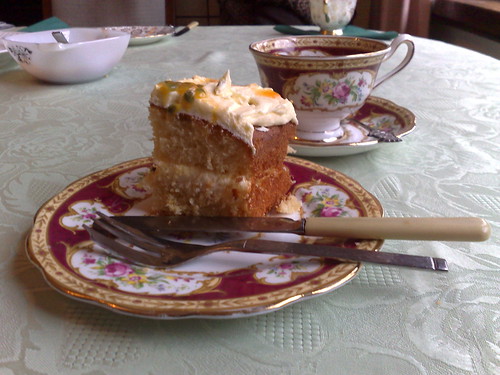
I think "Tea" is on of the most misunderstood and misinterpreted concepts out there. Afternoon tea, High tea, Tea, Dinner - all possibly meaning the same thing - or completely different ones.
So, let's go the panel and get a professionals' view.
AT HOME, HIGH AND FAMILY TEAS.
"At Home" Tea is served upon small tables, the servant before bringing it in seeing that one is placed conveniently near her mistress, who generally dispenses the tea. No plates are given for a tea of this kind, and the servant, or servants, after seeing that all is in readiness, leave the room, the gentlemen of the party doing all the waiting that is necessary.
The tea equipage is usually places upon a silver salver, the hot water is in a small silver or china kettle on a stand, and the cups are small. Thin bread and butter, sandwiches, cake, petits-fours and sometimes fresh fruit are all the eatables given. These are daintily arranged on plates, spread with lace doilies.
High Tea. - In some houses this is a permanent institution, quite taking the place of late dinner, and to many it is a most enjoyable meal, young people preferring it to dinner, it being a movable feast that can be partaken of at hours which will not interfere with tennis, boating, or other amusements. At the usual high tea there are probably to be found one or two small hot dishes, cold chicken, or game, tongue or ham, salads, cakes of various kinds, sometimes cold fruit tarts with cream or custard, and fresh fruit. Any supper dish, however, can be introduced, and much more elaborate meals be served, while sometimes the tea and coffee are relegated to the sideboard. In summer it is not unusual to have everything cold.
Family Teas. - At these meals cake, jam, sardines, potted meats, buttered toast, tea cakes and fruit are often provided, in addition to the tea, coffee, bread and butter. Watercress and radishes are nice in summer.
The hours for family teas may vary in many households, but are generally governed by the time of the dinner that has preceded them, and the kind of supper partaken of afterwards. Where this is of a very light character, such as a glass of wine and a slice of cake, or a more homely glass of beer and bread and cheese, a 6 to 7 o'clock tea would not be too later, and a few savouries or eggs would be needed in addition to the bread and butter and cake so generally found; but where a substantial supper is to follow the tea the latter would be of a very light description, and should be served as early as 4.30 to 6 o'clock.
Subscribe to:
Comments (Atom)
